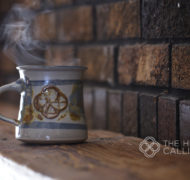We Are Still Here
Blog / Produced by The High Calling
The voices and friendships Laura Boggess has found here at The High Calling have helped her fill in the details of her own chalk outline, coaxed her writing voice into a rich, wide-lipped smile.
The neighbor children are tracing around each other’s bodies with sidewalk chalk. From my desk, I see them through the window taking it in turns to lie, still as a stone, on the driveway, offering their perimeter. It is a serious task, requiring the tracer to move her entire body around the placid figure she outlines.
I watch the girl thread the chalk between her brother’s feet, up the long path of his legs, around his arms, along the rugged terrain of shoulder and neckline. He smiles up at her and waits his turn as artist, plucking the thick stalk of color from her chalky fingers as they switch roles. They leave behind evidence in pinks and blues, yellows and greens: they were here; they are still here.
Later, I walk the dog under slow-moving clouds; the moist heat of the summer evening becomes my second skin. The neighborhood streets are quiet, hushed by the coming of night. In the fading daylight I dare to visit their chalky mural and let it tell me a story.
I see that each outline has been colored in with detail—a rainbow-striped skirt for the girl, the boy’s bright red hair in short-cropped curly loops, and long eyelashes and wide, full-lipped smiles for both. But the thing that tells the story is the way the children have joined their hands. I know they weren’t holding hands when the outlines were traced; I watched the making. But here they are, reaching out to each other in Technicolor, clutching tight with hands that look like tennis balls.
The writing life can be so Benedictine—we live cloistered, set apart, dedicated to tapping out words as prayer. And yet, in Writing Down the Bones, Natalie Goldberg says, “Writing is not just writing. It is also having a relationship with other writers … It’s much better to be a tribal writer, writing for all people and reflecting many voices through us, than to be a cloistered being trying to find one peanut of truth in our own individual mind. Become big and write with the whole world in your arms.”
How do you say goodbye to a community who has become your tribe? To the people who bring you the world and offer you their hearts in story? Over the years, The High Calling has become just that: a place of relationship. The voices and friendships I have found here have helped me fill in the details of my chalk outline, coaxed my writing voice into a rich, wide-lipped smile.
The day after the kids drew their chalk figures, one of those sudden, driving, summer storms blew through. I watched from the window as all that color ran down my neighbor’s driveway in rivulets. When the sun came out, the mural was gone. No rainbow-striped skirt, no wide-lipped smiles, no outstretched hands clasped together; every speck of color scoured clean.
I felt sad, until my neighbor’s screen door banged open. Out skipped the little girl in a rainbow-colored skirt. As he always does, her little brother followed close behind, red hair glinting.
Halfway across the drive, she reached out her hand. And when he reached out to take it, I felt my heart swell.
We were here. We are still here. Hands outstretched toward one another. Nothing can wash that away.





